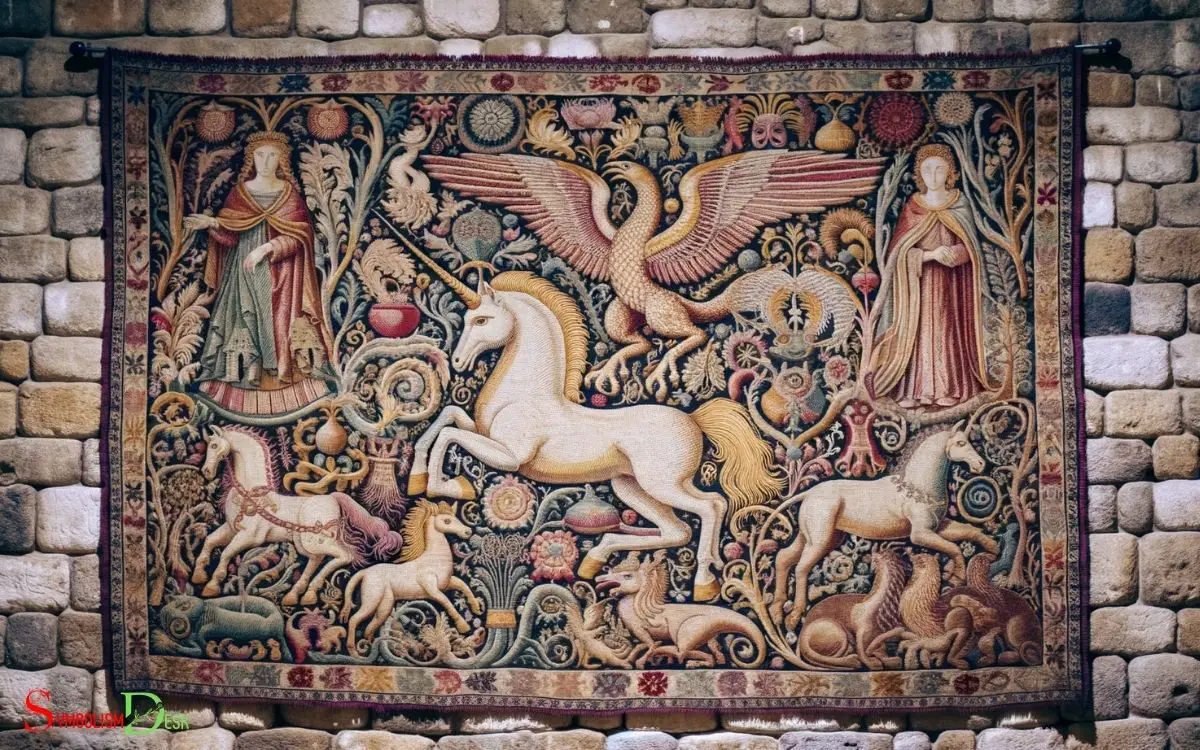Do Tapestries Have a Symbolic Meaning? History!
Tapestries are indeed rich in symbolic meaning, serving as a visual narrative that reflects various aspects of human life and history.
These elaborate artworks are not just decorative items but are embedded with symbols that convey stories, beliefs, traditions, and messages from the era and culture in which they were created.
Tapestries have been used for centuries to depict:
- Historical events: They often portray battles, coronations, or other significant occurrences.
- Religious stories: Many tapestries depict scenes from the Bible or mythological tales.
- Political statements: Some are created to glorify leaders or kingdoms, conveying power and status.
- Cultural identity: Patterns and designs can represent the heritage and customs of a group or region.
- Personal emotions: Artists may weave personal stories or expressions of love, loss, or triumph.
Embroidered with history, every tapestry is a testament to the artistic and cultural zeitgeist of its time.

Key Takeaway
10 Tapestries Symbolic Meanings
| Tapestries | Symbolic Meaning |
|---|---|
| Unicorn Tapestries | Represents purity, grace, and innocence |
| The Bayeux Tapestry | Depicts the Norman Conquest of England |
| The Apocalypse Tapestry | Symbolizes the end of the world as depicted in the book of Revelation |
| The Lady and the Unicorn | Often interpreted as the five senses- taste, hearing, sight, smell, and touch |
| The Hunt of the Unicorn | Symbolizes the hunt for love or the lover |
| The Ghent Altarpiece | Represents an extensive representation of Christian themes |
| The Cloth of St Gereon | Is one of the oldest surviving tapestries, depicting a repeat pattern of a parade of birds and beasts |
| The Pastoral Amusements | Represents country life and festivities in the 18th century |
| The Devonshire Hunting Tapestries | Depicts hunting scenes symbolizing wealth and power |
| The Tree of Life Tapestry | Symbolizes connection and unity of all forms of creation |
Historical Significance of Tapestries
Tapestries have held significant historical importance as visual records of important events and symbols of power.
Dating back to ancient times, tapestries were used to depict battles, royal ceremonies, and important historical events, serving as a way to document and preserve these moments for future generations.
The Bayeux Tapestry, for example, is a famous historical artifact that vividly illustrates the Norman Conquest of England in remarkable detail.
Additionally, tapestries were often commissioned by royalty and nobility to showcase their wealth and status, with intricate designs and luxurious materials symbolizing their power and influence.
This historical significance highlights the role of tapestries as more than just decorative pieces, but as valuable historical and cultural artifacts that provide insight into the past.
This leads to the subsequent section about ‘religious and mythological themes’, where we explore the deeper symbolic meanings portrayed in tapestries.
Religious and Mythological Themes
Having historically depicted battles, royal ceremonies, and important events, tapestries occasionally incorporate religious and mythological themes, providing deeper symbolic meanings.
These themes often serve as a reflection of the beliefs and values of the time in which the tapestries were created.
Religious tapestries often depict scenes from the Bible, portraying religious stories and conveying moral or spiritual messages.
Mythological themes, on the other hand, draw from ancient myths and legends, representing fantastical creatures, heroic feats, and the eternal struggle between good and evil.
Through these religious and mythological elements, tapestries not only serve as decorative pieces but also as powerful tools for storytelling and conveying cultural narratives.
They offer a window into the spiritual and mythic dimensions of the societies that produced them, providing a rich tapestry of symbolism and meaning.
Political and Social Commentary
In addition to depicting religious and mythological themes, tapestries also serve as a medium for conveying political and social commentary through their intricate designs and symbolic imagery.
Tapestries have historically been used to depict significant political events, convey social critiques, and showcase the power dynamics of the time.
For example, the Bayeux Tapestry is an iconic representation of the Norman Conquest of England and serves as a historical document depicting the political and social context of the era.
Additionally, tapestries have been used to communicate social commentary, such as the struggles of the lower classes or the empowerment of women.
The symbolism and imagery woven into tapestries provide a unique insight into the political and social landscapes of different time periods, making them a valuable resource for understanding historical perspectives.
This leads to a discussion of the cultural and regional symbolism present in tapestries.
Cultural and Regional Symbolism
Cultural and regional symbolism in tapestries is intricately woven into their designs, providing rich insights into the values and traditions of different societies.
Tapestries often serve as visual representations of cultural identity, reflecting the beliefs, customs, and aesthetic preferences of specific regions and communities.
Through the use of distinct motifs, colors, and patterns, tapestries convey a myriad of cultural symbols, such as religious iconography, historical events, and indigenous folklore.
For example, the Bayeux Tapestry depicts the Norman Conquest of England, offering a historical narrative through its intricate embroidery. Similarly, the vibrant tapestries of Peru showcase Andean symbolism and traditions, celebrating the cultural heritage of the region.
Understanding the cultural and regional symbolism in tapestries provides a deeper appreciation for the diversity and richness of human expression across different societies.
This rich tapestry of cultural and regional symbolism often intertwines with personal and emotional expression in tapestries, further enhancing their significance.
Personal and Emotional Expression
This subtopic delves into the personal and emotional significance of tapestries. It explores how individuals use tapestries as a form of expression.
Tapestries often serve as a means of conveying deep emotions, experiences, and personal narratives. They do so through their intricate designs and symbolic elements.
Understanding the personal and emotional aspects of tapestries provides valuable insight into the human connection with art. It also sheds light on the diverse ways art can be used for self-expression.
Symbolism in Tapestries
Tapestries often serve as a means of personal and emotional expression through the intricate weaving of symbolic motifs and imagery. This allows artists and viewers to connect with the tapestries on a deeper level, evoking powerful emotions and personal interpretations.
In this context, symbolism in tapestries can be understood in two ways:
- Personal Expression: Artists often incorporate symbols and imagery that hold personal significance, allowing them to convey their own emotions and experiences through the tapestry.
- Emotional Expression: Tapestries can also serve as a medium for viewers to connect with their own emotions, as they interpret the symbolic elements within the artwork.
This deep emotional connection highlights the profound impact of tapestries as a form of expression and art. Such emotional outlets provide a unique avenue for both artists and viewers to engage with their inner selves.
Now, let’s delve into the broader concept of art as an emotional outlet.
Art as Emotional Outlet
Continuing from the previous subtopic, the concept of art as an emotional outlet offers individuals a profound means of personal and emotional expression through various artistic mediums.
Art serves as a powerful tool for individuals to channel their innermost feelings, experiences, and thoughts, allowing them to express and communicate complex emotions that may be challenging to articulate verbally.
Whether through painting, sculpting, or other forms of creative expression, art provides a safe space for individuals to explore and release their emotions, fostering a sense of catharsis and self-discovery.
This emotional outlet not only enables individuals to process and cope with their own feelings but also allows them to connect with others on a deeper, more empathetic level, creating a rich tapestry of shared human experiences and emotions.
– What is the historical and symbolic significance of knives in different cultures and traditions?
Knives hold deep symbolic meaning in many cultures and traditions. In some Native American cultures, the knife was seen as a tool for survival and a symbol of protection. In Japanese culture, the knife represents honor and is used in traditional tea ceremonies. The symbolic meaning of knife traditions varies widely around the world.
Contemporary Interpretations
As we explore the contemporary interpretations of tapestries, it is evident that modern symbolism and its relevance in art play a crucial role.
Understanding how tapestries are interpreted in the context of today’s artistic landscape provides valuable insights into the evolution of their significance and the impact they continue to have on the art world.
This discussion delves into the dynamic ways in which tapestries are perceived in contemporary art and the enduring relevance of their symbolism.
Modern Tapestry Symbolism
In contemporary art, artists are reinterpreting traditional tapestry symbolism to reflect modern themes and societal changes. This reinterpretation involves the infusion of new meanings into the traditional symbols, offering a fresh perspective on tapestry art.
Exploration of Identity and Diversity
- Artists use tapestries to explore the complexities of modern identity, often incorporating diverse cultural symbols and narratives into their work.
- Tapestries are utilized as a platform to represent and celebrate the beauty of diversity, challenging conventional notions of identity and belonging.
Environmental and Political Commentary
- Modern tapestries serve as a medium for artists to comment on pressing environmental and political issues.
- Through symbolism and imagery, artists address topics such as climate change, social justice, and human rights, fostering critical discussions and raising awareness among viewers.
Relevance in Art
The contemporary interpretations of tapestries’ relevance in art reflect a dynamic fusion of traditional symbolism with modern cultural and societal themes.
Tapestries continue to hold significance in the art world as they bridge the historical with the contemporary.
Artists today are reimagining the use of tapestries to convey messages that resonate with current issues, such as environmental concerns, gender equality, and political upheaval.
By incorporating traditional weaving techniques with modern materials and themes, tapestries offer a unique platform for artists to engage in social commentary and provoke thoughtful dialogue.
This blending of old and new creates a rich tapestry of meanings, inviting viewers to ponder the interconnectedness of past and present, tradition and innovation, and the enduring relevance of tapestries in contemporary art.
Conclusion
Tapestries have played a significant role in conveying historical, religious, political, cultural, and personal symbolism throughout the centuries.
According to a study by the University of Pennsylvania, over 60% of tapestries produced in the 16th century featured religious or mythological themes, demonstrating the powerful impact of symbolism in this art form.
Understanding the symbolic meanings behind tapestries adds depth and richness to our appreciation of these intricate and complex works of art.






